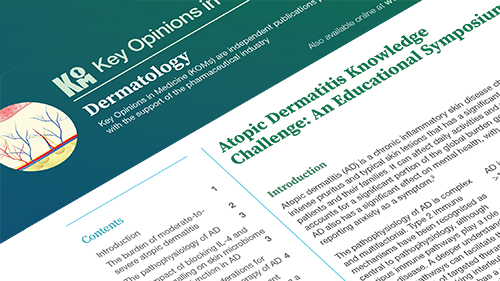Atopic Dermatitis: Disease Burden, Pathophysiology, and Treatment with Dupixent
Highlights from the 2023 EADV ‘Atopic Dermatitis Knowledge Challenge – an Education Symposium’
Abstract
The ‘Atopic Dermatitis Knowledge Challenge – an Education Symposium’ was conducted on May 19th 2023 as a part of the European Academy of Dermatology and Venereology’s Spring Symposium series. Dr. Ignasi Figueras from the University of Barcelona and Dr. Alexandra Golant from Mount Sinai Hospital, USA, discussed the disease burden, pathophysiology, and effectiveness of Dupixent—the first treatment approved in the European Union (EU) for severe atopic dermatitis (AD) in children between the ages of 6 months to 11 years who are candidates for systemic therapy.
This article highlights the key takeaways from the symposium. It presents the impact of inadequately controlled AD in infants and children, the role of specific cytokines in AD, and the growing evidence for the clinical efficacy and safety of Dupixent in AD. Real-world considerations in the selection of a systemic therapy for the treatment of uncontrolled AD in infants, children, and adults are also discussed.
Introduction
AD is a common chronic inflammatory condition characterised by pruritic and itchy skin lesions1,2. Genetic predisposition, environmental factors such as exposure to allergens or pathogens, and dysregulated inflammatory mechanisms contribute to the development of AD3. Upregulation of type-2 immune responses leading to skin barrier dysfunction plays a key role in the pathogenesis of AD2. The resulting itch and skin lesions are a characteristic of AD and can cause significant pain and discomfort, sleep impairment, poor physical and mental health, and impacted quality of life (QoL)4.
While topical corticosteroids and systemic immunosuppressants have demonstrated rapid effectiveness in patients with AD, their long-term use can lead to serious adverse effects5. Given the chronic and relapsing nature of the disease, patients with AD require long-term systemic therapies for adequate disease control. However, systemic treatments that are effective in adults are not approved for paediatric patients5. In children with uncontrolled AD, despite the use of topical treatments, there is an unmet need for effective and targeted systemic therapies.
Impact of AD on infants and children and their caregivers
According to the EPI-CARE data collected from across 18 countries, the prevalence of AD ranges from 12.1% in children aged between 6 months and 6 years, and 13.0% in children aged between 6 and 12 years1. The severity of the disease has a significant effect on prognosis. Younger children are more likely to develop severe AD and are at a higher risk of hospitalisation, compared to those with mild-to-moderate AD. Further, early onset of AD is associated with a significantly lower QoL1,2,5.
The impact of AD on the QoL is more pronounced in infants and young children since the early years are crucial for their mental and social development. Children with AD have been reported to experience loss of sleep, altered educational trajectory, poor career choices, and reduced self-esteem, along with greater anxiety and other mental comorbidities4. Moreover, appearance-related stigma and pain makes them less likely to participate in sports activities and social events and increases the likelihood of missing school5.
Furthermore, AD can have a significant impact on the QoL of family members and caregivers of paediatric patients4. Health expenditure, sleep, and mental health have been reported as the most impacted areas in the lives of caregivers of children with AD1, 2.
The perception of a healthcare professional regarding the impact of AD on a patient, versus the patients’ own perception can be different6. Therefore, in addition to the diagnosis of skin lesions and clinical symptoms of AD, an assessment of its impact on the patient’s mental health and QoL is essential in order to devise an effective management strategy. Given the life-long impact of AD on affected children, early initiation and continuous treatment with systemic therapies is needed to ensure adequate disease control.
Pathophysiology of AD and therapeutic targets
Type-2 inflammation—which normally confers immunity against parasitic pathogens in healthy individuals—plays a central role in the pathogenesis of AD. It may be limited to certain tissues or organs like the skin, gastrointestinal tract, or airway, or may occur systemically. Moreover, an individual may experience multiple type-2 inflammation-related diseases3.
The secretion of cytokines interleukin (IL-) 4 and IL13, by T helper (Th) lymphocytes and innate lymphoid cells in response to an allergen or microbe, and subsequent activation of mast cells and eosinophils, has been shown to drive type-2 inflammation3. Additionally, IL-5 and IL-31 have also been shown to contribute to type-2 inflammation as accessory cytokines3.
Secretion of IL-4 and IL-13 is known to cause dysfunction of the skin barrier and increase its susceptibility to infections, while IL-31 secretion is responsible for the itch associated with AD3. Furthermore, IL-4 induces the differentiation of naïve T cells to Th2 cells; the latter then secrete IL-4, IL-13, and IL-31. This positive feedback loop caused by IL-4 secretion leads to an increase in type-2 inflammation and associated symptoms3.
Targeting the inflammatory cytokines involved in type-2 inflammation is therefore likely to be a promising therapeutic strategy for AD.
Efficacy and safety of Dupixent, a targeted immunomodulator
Dupilumab, also known by the trade name Dupixent, is a monoclonal antibody that specifically targets and inhibits IL-4 and IL-13 signaling1.
Clinical studies have demonstrated the efficacy and safety of Dupixent in the treatment of AD across different patient categories, including infants, children, adolescents, and adults with moderate-to-severe AD. These include the LIBERTY AD SOLO 1 and 2, LIBERTY AD CAFÉ, and LIBERTY AD CHRONOS clinical trials1,2,7,8.
Pooled data from the above studies shows that treatment with Dupixent markedly improved the clearance of skin lesions. On the mean eczema area and severity index score or EASI score, it demonstrated improvements in infants and children, children, adolescents, and adults with AD by 70%, 82%, 66%, and 70%, respectively. Further, improvement in skin clearance following treatment was consistent over 16 weeks. Treatment was also associated with improvements in itch—a characteristic symptom of AD—in the respective patient groups, by 49%, 55%, 48%, and 47%, respectively1,2,7,8.
In terms of the impact of Dupixent treatment on the QoL of patients with AD, the clinical trials demonstrated a significant improvement by 9 to 10 points on the Dermatology Life Quality Index, from baseline scores across all patient groups8. Post-hoc analysis of stratified clinical data on the effectiveness of Dupixent revealed findings consistent with the pooled data9. Significant improvements in skin clearance, itch, and QoL were noted at week 16 and week 52 in patients with moderate and severe AD who received Dupixent, relative to those who received a placebo9.
Lesions on visible skin surfaces, such as the hands and feet, can have a deeper impact on the functional ability and self-esteem of affected individuals. Studies have shown that Dupixent treatment was associated with rapid clearance of lesions on the hands and feet in 16 weeks in adolescents, along with improvements in sleep quality, itch, and QoL10.
Finally, real-word studies on a cohort of 38,075 patients with AD across 32 countries support the clinical effectiveness and safety of Dupixent in the treatment of AD11,12. Patients were able to achieve disease control as early as one month following treatment, and these effects were sustained up to three years10,11,12. Moreover, a significantly higher proportion of patients reported that they were satisfied with the treatment.
Notably, Dupixent was found to be safe and effective in patients as young as 6 months, underscoring its efficacy and safety in a wide patient population.
With regards to safety, Dupixent demonstrated a consistent safety profile for up to 5 years and was tolerated well across all patient groups1,2,8. The most common adverse events (AEs) included exacerbation of AD lesions, injection site reactions, conjunctivitis, and nasopharyngitis. However, most AEs could be managed with standard treatments, with only a few patients needing to discontinue treatment due to adverse effects8.
Compared to other systemic therapies, Dupixent administration does not require screening for viral hepatitis, tuberculosis, cardiovascular events, malignancies, and serious infections, or routine blood assessments for blood count, lipid profile, and liver function13. These features make it an effective, yet simpler, and targeted alternative to other systemic immunosuppressants.
Overall, the data from these studies suggest Dupixent to be a robust, safe, and effective treatment for AD in a wide spectrum of patients, who vary in age and disease severity.
Dupixent’s role in improving skin barrier function and infections in patients with AD
The skin barrier is regulated by microbial, physical, chemical, immunological, and neuro-sensory mechanisms. It plays an important role in hydration, preventing the entry of allergens or pathogens, mediating immune responses, and transmission of sensory signals like an itch to the nervous system14.
Type-2 inflammation is known to impact the structure and function of the normal, intact skin barrier through various mechanisms. These include modification of lipid and protein components and metabolism; perturbation of epidermal proteases, sweat glands, and tight-junctions; and microbial dysbiosis3,14.
These disturbances in the integrity of the skin barrier make it susceptible to exposure to allergens and microbial colonisation, which can further increase inflammation.
Staphylococcus aureus, a normal microbial inhabitant of human skin, is known to exacerbate barrier dysfunction, inflammation, and itch in AD. In a feedback loop, an increase in skin damage and inflammation allows increased growth of S. aureus, thereby inhibiting the growth of other skin microflora. Overall, 20%–30% patients with AD experience S. aureus colonisation, which further increases the risk of other inflammatory diseases and skin infections. Further, 16% of patients with AD experience skin infections, which are associated with an increased risk of hospitalisation and visits to the emergency department14,15.
A clinical study assessing the effects of Dupixent on the skin barrier showed that treatment was associated with improvements in stratum corneum ceramide composition (lipids in the skin barrier), significant reduction in epidermal hyperplasiarelated proteins, and improvement in skin barrier function14.
Further, Dupixent treatment reduced the leakage of blood proteins into the lesion, thereby reducing S. aureus colonisation and reducing the risk of herpetic and bacterial skin infections15.
Clinical considerations for systemic therapy with Dupixent
Patients with AD who do not show improvements following topical treatments may be considered for systemic therapies. Children aged between 6 months and 12 years with moderate-to-severe AD can be considered suitable candidates for systemic treatment with Dupixent.
The presence of comorbidities and cardiovascular and venous thromboembolism (VTE) risk factors can affect the efficacy of systemic treatments16. While devising a systemic treatment regimen for AD, it may therefore be important to assess patients for cardiovascular and VTE risk factors.
Summary
- Inadequate control of AD can have a significantly negative impact on the health, future, and QoL of paediatric patients with AD.
- AD is driven by systemic type-2 inflammation which causes skin barrier dysfunction, resulting in a scratch-itch cycle.
- IL-4 and IL-13 are the key cytokines involved in AD pathogenesis.
- Dupixent—a targeted immunomodulator that inhibits IL-4 and IL-13 signalling—is a safe and effective treatment for AD in a wide range of patients, including those as young as 6 months.
- Treatment with Dupixent is associated with skin clearance, reduction in itch, improvement in QoL, and improvement in skin barrier function and infections, in patients with AD.
References
- Paller AS, et al. (2022). Dupilumab in children aged 6 months to younger than 6 years with uncontrolled atopic dermatitis: a randomised, double-blind, placebo-controlled, phase 3 trial. Lancet; 17;400(10356):908–919.
- Paller AS, et al. (2020). Efficacy and safety of dupilumab with concomitant topical corticosteroids in children 6 to 11 years old with severe atopic dermatitis: A randomized, double blinded, placebo-controlled phase 3 trial. Journal of the American Academy of Dermatology; 83(5):1282–1293.
- Beck LA, et al. (2022). Type 2 Inflammation Contributes to Skin Barrier Dysfunction in Atopic Dermatitis. JID Innovations; 2(5):100131.
- Bashyam AM, et al. (2021). Lifelong Impact of Severe Atopic Dermatitis on Quality of Life: A Case Report. Dermatology and Therapy; 11(3): 1065–1070.
- Siegfried EC, et al. (2019). Use of dupilimab in pediatric atopic dermatitis: Access, dosing, and implications for managing severe atopic dermatitis. Pediatric Dermatology; 36: 172–176.
- Bruin-Weller M, et al. (2021). Efficacy of Dupilumab in Atopic Dermatitis: The Patient’s Perspective. Dermatology and Therapy; 11:2123–2131.
- Thaçi D, et al. (2019). Efficacy and safety of dupilumab monotherapy in adults with moderate-to-severe atopic dermatitis: a pooled analysis of two phase 3 randomized trials (LIBERTY AD SOLO 1 and LIBERTY AD SOLO 2). Journal of Dermatological Science; 94(2):266–275.
- Weidinger S, et al. (2023). Efficacy of dupilumab in moderate and severe atopic dermatitis. Journal of the European Academy of Dermatology and Venerology; 2(2): 247–260.
- Simpson EL, et al. Poster presented at the AAD congress, 1721 March 2023, New Orleans, LA, USA. 2. ClinicalTrials.gov. NCT04417894. Accessed April 25, 2023.
- Beck LA, et al. (2020). Dupilumab Provides Favorable Safety and Sustained Efficacy for up to 3 Years in an Open-Label Study of Adults with Moderate-to-Severe Atopic Dermatitis. American Journal of Clinical Dermatology; 21(4):567–577.
- Simpson E, et al. (2019). Validation of the Atopic Dermatitis Control Tool (ADCT©) using a longitudinal survey of biologictreated patients with atopic dermatitis. BMC Dermatology; 19(1):15.
- Ong P, et al. (2022). Real-world analysis of skin infections and antimicrobial use among patients with atopic dermatitis before and after initiation of dupilumab treatment. Journal of the American Academy of Dermatology; 87(3).
- Wollenberg A, et al. (2018). Consensus-based European guidelines for treatment of atopic eczema (atopic dermatitis) in adults and children: part I. Journal of the European Academy of Dermatology and Venerology; 32(5):657-682.
- Bissonnette R, et al. Dupilumab treatment restores skin barrier function and improves clinical and patient reported outcomes in adults and adolescents with moderate to severe atopic dermatitis. Poster presented at the 2022 Annual Meeting of the American Academy of Dermatology.
- Beck L, et al. Poster presented at the annual meeting of the American Academy of Allergy, Asthma, and Immunology, February 2022.
- Merola JF, et al. Poster presented at the 2022 Revolutionizing Atopic Dermatitis (RAD) Virtual Conference; 2022; December 11.




